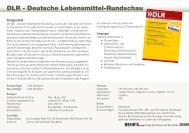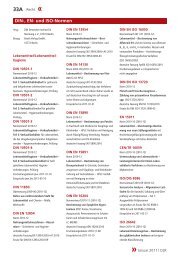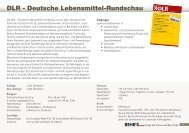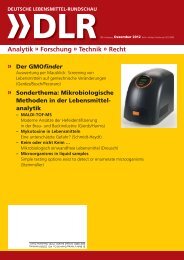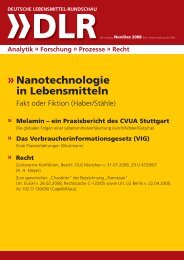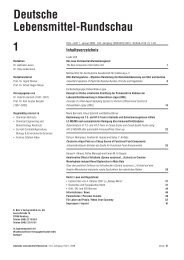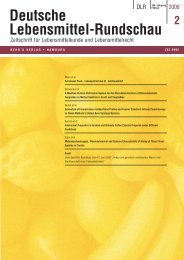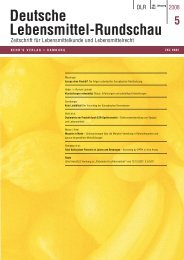Recht - DLR Online
Recht - DLR Online
Recht - DLR Online
Sie wollen auch ein ePaper? Erhöhen Sie die Reichweite Ihrer Titel.
YUMPU macht aus Druck-PDFs automatisch weboptimierte ePaper, die Google liebt.
of acid and ethanol during the cultivation process. On the<br />
other hand, in case of bioreactor culture, the DO decreased<br />
gradually during the growth phase and increased gradually<br />
thereafter as cells entered the stationary phase. As observed<br />
also in the previous experiment, the oxygen was not limited<br />
during the cultivation process.<br />
Cultivation of S. boulardii in completely semi-defined medium<br />
in shake flask and stirred tank bioreactor<br />
Based on the data of the previous experiments, three different<br />
parallel cultivations were conducted using semi-defined<br />
medium supplemented with yeast extract in concentration of<br />
5 g l -1 . Cultivations were conducted in both shake flask and<br />
bioreactors under controlled and uncontrolled pH conditions<br />
(Fig. 3). In case of shake flask cultures, cells grew exponentially<br />
reaching the maximal cell mass of about 3.1 g l -1 after<br />
about 12 h and decreased gradually thereafter. During the<br />
growth phase the pH decreased reaching its minimal value<br />
of 2.9 after 17 h. On the other hand, cells grew in different<br />
manner in case of bioreactor cultures. The rate of glucose<br />
consumption in case of bioreactor culture was higher than<br />
shake flask culture. At the end of cultivation time, 25 % and<br />
Fig. 3 Kinetics of cell growth, glucose consumption and different growth<br />
parameters during the cultivation of S. boulardii in complete defined medium<br />
supplemented by yeast extract (5 g l -1 ) under different cultivation conditions:<br />
(A) shake flask culture, (B) bioreactor culture (uncontrolled pH), (C) bioreactor<br />
culture (controlled pH at 5.5)<br />
12 % of the initial glucose were un-utilized by cells in case<br />
of shake flask and bioreactor cultures, respectively. Whereas,<br />
glucose was completely consumed in bioreactor culture of<br />
controlled pH at 5.5 (Fig. 3C). After only 10 h cultivation,<br />
glucose was the limiting nutrient in this culture and cells<br />
entered the stationary phase as carbon source limitation.<br />
Oxygen was in excess in this culture and the lowest value of<br />
DO was 25 % saturation as cell entered the stationary phase.<br />
In general, the final cell mass in this experiment was significantly<br />
higher than the previous experiment on using completely<br />
defined medium. Yeast extract supplementation to the<br />
cultivation medium was necessary as an important source for<br />
amino acids, peptides and soluble vitamins. However, yeast<br />
extract was found to be necessary for cell growth and the<br />
production of enzymes, primary and secondary metabolites<br />
by different types of microorganisms (Kadowaki et al., 1988;<br />
Costa et al., 2002; López et al., 2003; Lin and Chen, 2007).<br />
Fed-batch cultivation of S. boulardii in semi-defined medium<br />
with different feeding strategies<br />
Based on the data of batch cultivation of S. boulardii in<br />
semi-defined medium under pH-stat in bioreactor, cultivations<br />
were carried out under the same cultivation conditions<br />
with two different methods of feeding strategies. Since cell<br />
viability and its fermentative capacity are important for further<br />
application of therapeutic yeast, fed-batch cultivation<br />
was designed to start glucose feeding before carbon source<br />
starvation in culture. The negative effect of carbon starvation<br />
in culture can induce energy deprivation and loss of<br />
fermentative capacity of yeast (Thomsson et al., 2003).<br />
Fed Batch cultivation with mono-substrate with an increased<br />
feeding rate<br />
Cultivation was carried out as typical batch culture in<br />
bioreactor for the first 9 h. During that time, cells grew<br />
exponentially and reached cell mass of about 4.1 g l -1 . On<br />
the other hand, glucose concentration gradually decreased<br />
during this phase. The glucose consumption rate was of<br />
about 2 g l -1 h -1 and the glucose concentration reached<br />
about 4 g l -1 at the end of batch phase. Therefore, glucose<br />
was fed with the same consumption rate to prevent carbon<br />
limitation. However, the feeding rate of glucose was<br />
increased by 2 g l -1 h -1 every 5 h to compensate the increased<br />
volumetric consumption rate of glucose as a result<br />
of further cell growth. As shown in Figure 4, the cell mass<br />
increased significantly during the glucose feeding phase<br />
reaching about 18 g l -1 after 20 h. The cell growth was<br />
terminated after that time and glucose was accumulated in<br />
culture in high concentration as cell entered the stationary<br />
phase. During the active growth phase of fed-batch culture,<br />
from 9 to 20 h, the value of DO was below 20 %<br />
saturation and increased gradually thereafter and reached<br />
about 80 % after 30 h. The gradual increase in DO value<br />
in culture with very low rate directly indicates the termination<br />
of cell growth and the high viability of cells pro-<br />
426 ı Originalarbeiten Deutsche Lebensmittel-Rundschau ı 104. Jahrgang, Heft 9, 2008




